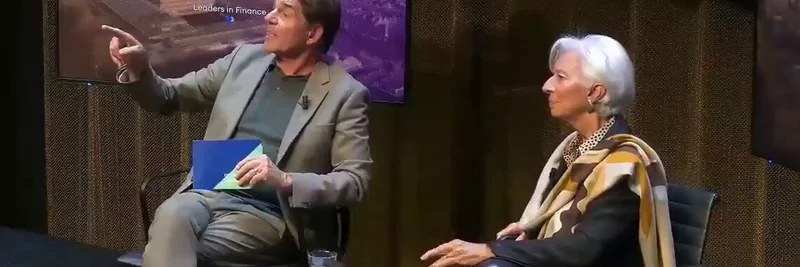Hey there, crypto enthusiasts! If you've been scrolling through X (formerly Twitter) lately, you might have stumbled upon a fiery thread that's got the Bitcoin community buzzing. It all started with a clip from ECB President Christine Lagarde's appearance on what looks like the "College LIF: Leaders in Finance" show, where she was asked point-blank: "How many Bitcoin do you own?" Spoiler: her response didn't exactly endear her to the crypto crowd.
In the original thread posted by Eli Nagar, CEO of Braiins Mining and a vocal Bitcoin advocate, he breaks down Lagarde's criticisms one by one. Nagar calls the host's question "stupid" and says things go "downhill fast" as Lagarde trots out familiar anti-Bitcoin talking points. Let's dive into the key arguments and Nagar's counterpunches, keeping things simple for anyone new to the space.
Lagarde's Take: Bitcoin Has No Intrinsic Value
Lagarde argues that Bitcoin lacks any underlying or intrinsic value, describing it as hype fueled by a passionate community. She contrasts this with what she sees as more stable options like a digital euro.
Nagar fires back: "Neither does fiat." He points out that "intrinsic value" is an outdated concept in economics. Money gets its worth from scarcity, credibility, and demand. Bitcoin's supply is capped at 21 million coins, enforced by math, while fiat currencies like the euro can be printed endlessly by central banks.
This hits home for meme token fans. Meme coins like Dogecoin or newer ones on Solana thrive on community hype and scarcity mechanics too. If Bitcoin's value comes from its network and believers, imagine how that amplifies for memes, where virality is the name of the game.
No Anchor of Safety?
According to Lagarde, Bitcoin doesn't have a reliable "anchor" to keep it stable, making it risky.
Nagar counters that Bitcoin's anchor is energy—specifically, the massive computational power (proof-of-work) that secures the network. Every Bitcoin represents real-world energy expended, unlike fiat, which relies on trust in institutions that can devalue it through inflation.
For blockchain practitioners, this underscores why decentralized networks are resilient. Meme tokens often ride on established chains like Ethereum or Solana, inheriting that security while adding cultural layers that drive adoption.
Could It Collapse?
Lagarde warns that Bitcoin could crash spectacularly.
Nagar reminds us that any system can fail, but Bitcoin has chugged along with near-perfect uptime for over 15 years, surviving global crises, bans, and market dips. Compare that to traditional banking meltdowns that happen regularly.
This resilience is a big draw for meme coins too. While they're volatile, the underlying blockchain tech keeps them alive, allowing communities to rally and recover in ways fiat can't.
It's Just Speculation
She calls Bitcoin purely speculative, like a gamble.
Nagar agrees—sort of. He says every new monetary asset starts that way: gold in ancient times, bonds centuries ago. Bitcoin's price swings are part of its discovery phase, a feature, not a bug.
Meme tokens embody this speculation on steroids. They're often launched as jokes but can explode based on trends and community engagement. Lagarde's view might dismiss them outright, but that's missing how speculation drives innovation in crypto.
A Digital Euro Is Safer
Lagarde promotes central bank digital currencies (CBDCs) like a digital euro as a secure alternative.
Nagar sees this as a trap: CBDCs aren't true ownership; they're programmable money controlled by authorities. Bitcoin, on the other hand, is yours—no permissions needed.
This is crucial for meme token users. In a world of CBDCs, decentralized assets like memes offer freedom from oversight, letting creators and holders operate independently.
Stablecoins Are Different
Finally, she differentiates stablecoins, seeing them as more legitimate.
Nagar notes they're basically IOUs, dependent on issuers' trust—exactly what Bitcoin eliminates by being a bearer asset.
Meme coins aren't stablecoins, but this highlights the spectrum in crypto. While stables provide pegged value, memes offer uncapped potential through narrative and fun.
The Bigger Picture for Meme Tokens
Nagar wraps up by flipping the script: every critique Lagarde levels at Bitcoin actually describes fiat better. "Trust math, not mandates," he says.
This thread, with over 1,700 likes and hundreds of reposts as of October 9, 2025, shows how traditional finance still clashes with crypto's ethos. For meme token enthusiasts, it's a reminder that community is king. Lagarde's dismissal of "hype" ignores how it builds real value in projects like PEPE or SHIB, where holders turn memes into movements.
If you're in blockchain, threads like this are gold for understanding the pushback from regulators. It also spotlights why self-custody and decentralization matter—core principles that meme coins, despite their whimsy, often embody.
What do you think? Is Lagarde out of touch, or does she have a point? Drop your thoughts in the comments, and stay tuned to Meme Insider for more on how these debates shape the token landscape.


